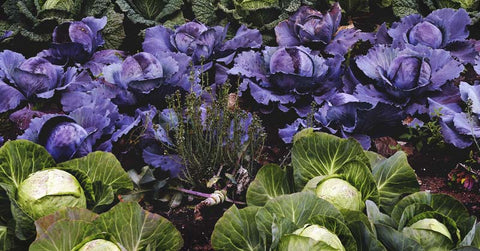Harvesting your own garden produce is one of the most rewarding experiences for any gardener. Whether you're growing fruits, vegetables, or herbs, the satisfaction of picking fresh, flavorful produce straight from your garden is unparalleled. However, proper harvesting and storage techniques are essential for preserving the freshness, flavor, and nutritional value of your homegrown bounty. In this blog, we'll explore the best practices for harvesting and storing garden produce to maximize freshness and flavor, from knowing when to harvest to the best methods for storing different types of produce.

Knowing When to Harvest
- Observation: The first step in harvesting garden produce is knowing when the fruits, vegetables, or herbs are ripe and ready for picking. This requires regular observation of your garden and close attention to the signs of ripeness for each type of produce.
- Visual Cues: Look for visual cues such as color changes, size, and texture to determine ripeness. For example, ripe tomatoes will be fully colored and slightly soft to the touch, while ripe cucumbers will have a uniform green color and firm texture.
- Taste Test: When in doubt, conduct a taste test to determine if the produce is ready for harvest. Sample a small piece of fruit or vegetable to assess its flavor, sweetness, and overall quality. The taste test is especially useful for determining the optimal harvest time for fruits such as strawberries, berries, and melons.
- Harvesting Time: Harvesting should ideally be done in the early morning or late afternoon when temperatures are cooler. This helps preserve the freshness and flavor of the produce by reducing moisture loss and minimizing exposure to heat.

Harvesting Techniques
- Gentle Handling: Handle garden produce with care to avoid bruising, crushing, or damaging the delicate fruits and vegetables. Use a sharp knife, pruning shears, or scissors to cut the produce from the plant, leaving a small stem attached if possible.
- Harvesting Frequency: Harvest fruits and vegetables regularly to encourage continued production and prevent overripening or spoilage. Check your garden daily for ripe produce and harvest as needed to keep plants productive and healthy.
- Timing: Harvest leafy greens and herbs when they are young and tender for the best flavor and texture. For root vegetables such as carrots and radishes, wait until they reach their mature size but harvest before they become woody or pithy.
- Storage Preparation: Prepare garden produce for storage immediately after harvest by removing any dirt, debris, or damaged areas. Wash leafy greens and herbs gently in cold water and pat dry with a clean towel to remove excess moisture.
Storing Garden Produce
- Cool, Dry Location: Store garden produce in a cool, dry location away from direct sunlight to extend shelf life and preserve freshness. A root cellar, basement, or refrigerator crisper drawer are ideal storage locations for most fruits and vegetables.
- Proper Ventilation: Ensure proper ventilation to prevent moisture buildup and reduce the risk of mold and rot. Use perforated plastic bags, breathable mesh bags, or vegetable storage bins with ventilation holes to allow air circulation around the produce.
- Temperature and Humidity: Different types of produce have specific temperature and humidity requirements for optimal storage. Leafy greens and herbs prefer cooler temperatures (around 32-40°F) with high humidity, while fruits such as tomatoes and peppers prefer slightly warmer temperatures (around 50-55°F) with low humidity.
- Avoiding Ethylene Exposure: Some fruits and vegetables produce ethylene gas, which can accelerate ripening and spoilage in other produce. Store ethylene-sensitive fruits and vegetables such as apples, berries, and leafy greens away from ethylene-producing fruits such as bananas, apples, and tomatoes to prevent premature ripening and spoilage.

Tips for Storing Specific Types of Produce
- Root Vegetables: Store root vegetables such as carrots, beets, and potatoes in a cool, dark place with high humidity to prevent sprouting and spoilage. Remove any greens or tops before storing them to prevent moisture loss.
- Leafy Greens and Herbs: Wrap leafy greens and herbs in damp paper towels or store them in breathable plastic bags to maintain moisture and prevent wilting. Store in the refrigerator crisper drawer for best results.
- Tomatoes: Store tomatoes at room temperature away from direct sunlight until fully ripe, then transfer them to the refrigerator to slow down ripening and prolong shelf life. Avoid storing tomatoes in plastic bags, as this can trap moisture and accelerate spoilage.
- Berries: Store berries such as strawberries, blueberries, and raspberries in the refrigerator crisper drawer in a single layer to prevent crushing and bruising. Rinse berries gently in cold water just before eating to remove any dirt or debris.
Conclusion
In conclusion, proper harvesting and storing techniques are essential for maximizing the freshness, flavor, and nutritional value of your garden produce. By knowing when to harvest, employing gentle harvesting techniques, and following best practices for storing different types of produce, you can enjoy the fruits of your labor for weeks to come. Whether you're stocking up for the winter months or enjoying a bountiful harvest at the peak of the growing season, these tips will help you make the most of your garden produce and savor the taste of homegrown goodness all year round. So, roll up your sleeves, head out to the garden, and start harvesting your own fresh, flavorful produce today!









